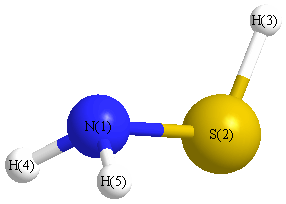Jump to
S1C2
Energy calculated at CCSD(T)=FULL/aug-cc-pVTZ
| | hartrees |
|---|
| Energy at 0K | -454.255075 |
| Energy at 298.15K | -454.258827 |
| HF Energy | -453.746904 |
| Nuclear repulsion energy | 57.663182 |
The energy at 298.15K was derived from the energy at 0K
and an integrated heat capacity that used the calculated vibrational frequencies.
Vibrational Frequencies calculated at CCSD(T)=FULL/aug-cc-pVTZ
| Mode Number |
Symmetry |
Frequency
(cm-1) |
Scaled Frequency
(cm-1) |
IR Intensities
(km mol-1) |
Raman Act
(Å4/u) |
Dep P |
Dep U |
|---|
| 1 |
A' |
3547 |
3418 |
|
|
|
|
| 2 |
A' |
2681 |
2584 |
|
|
|
|
| 3 |
A' |
1632 |
1573 |
|
|
|
|
| 4 |
A' |
1045 |
1007 |
|
|
|
|
| 5 |
A' |
887 |
855 |
|
|
|
|
| 6 |
A' |
663 |
639 |
|
|
|
|
| 7 |
A" |
3623 |
3492 |
|
|
|
|
| 8 |
A" |
1138 |
1096 |
|
|
|
|
| 9 |
A" |
423 |
408 |
|
|
|
|
Unscaled Zero Point Vibrational Energy (zpe) 7819.4 cm
-1
Scaled (by 0.9637) Zero Point Vibrational Energy (zpe) 7535.6 cm
-1
See section
III.C.1 List or set vibrational scaling factors
to change the scale factors used here.
See section
III.C.2
Calculate a vibrational scaling factor for a given set of molecules
to determine the least squares best scaling factor.
Geometric Data calculated at CCSD(T)=FULL/aug-cc-pVTZ
Point Group is Cs
Cartesians (Å)
| Atom |
x (Å) |
y (Å) |
z (Å) |
|---|
| N1 |
0.014 |
1.111 |
0.000 |
| S2 |
0.014 |
-0.618 |
0.000 |
| H3 |
-1.317 |
-0.772 |
0.000 |
| H4 |
0.496 |
1.446 |
0.821 |
| H5 |
0.496 |
1.446 |
-0.821 |
Atom - Atom Distances (Å)
| |
N1 |
S2 |
H3 |
H4 |
H5 |
| N1 | | 1.7294 | 2.3057 | 1.0094 | 1.0094 |
S2 | 1.7294 | | 1.3397 | 2.2731 | 2.2731 | H3 | 2.3057 | 1.3397 | | 2.9796 | 2.9796 | H4 | 1.0094 | 2.2731 | 2.9796 | | 1.6429 | H5 | 1.0094 | 2.2731 | 2.9796 | 1.6429 | |
 More geometry information
More geometry information
Calculated Bond Angles
| atom1 |
atom2 |
atom3 |
angle |
|
atom1 |
atom2 |
atom3 |
angle |
| N1 |
S2 |
H3 |
96.575 |
|
S2 |
N1 |
H4 |
109.360 |
| S2 |
N1 |
H5 |
109.360 |
|
H4 |
N1 |
H5 |
108.935 |
Electronic energy levels
Charges, Dipole, Quadrupole and Polarizability
Jump to
S1C1
Energy calculated at CCSD(T)=FULL/aug-cc-pVTZ
| | hartrees |
|---|
| Energy at 0K | -454.254466 |
| Energy at 298.15K | -454.258275 |
| HF Energy | -453.747145 |
| Nuclear repulsion energy | 57.842198 |
The energy at 298.15K was derived from the energy at 0K
and an integrated heat capacity that used the calculated vibrational frequencies.
Vibrational Frequencies calculated at CCSD(T)=FULL/aug-cc-pVTZ
| Mode Number |
Symmetry |
Frequency
(cm-1) |
Scaled Frequency
(cm-1) |
IR Intensities
(km mol-1) |
Raman Act
(Å4/u) |
Dep P |
Dep U |
|---|
| 1 |
A' |
3551 |
3422 |
|
|
|
|
| 2 |
A' |
2614 |
2519 |
|
|
|
|
| 3 |
A' |
1621 |
1562 |
|
|
|
|
| 4 |
A' |
1025 |
988 |
|
|
|
|
| 5 |
A' |
885 |
853 |
|
|
|
|
| 6 |
A' |
639 |
616 |
|
|
|
|
| 7 |
A" |
3636 |
3504 |
|
|
|
|
| 8 |
A" |
1122 |
1081 |
|
|
|
|
| 9 |
A" |
512 |
494 |
|
|
|
|
Unscaled Zero Point Vibrational Energy (zpe) 7802.7 cm
-1
Scaled (by 0.9637) Zero Point Vibrational Energy (zpe) 7519.4 cm
-1
See section
III.C.1 List or set vibrational scaling factors
to change the scale factors used here.
See section
III.C.2
Calculate a vibrational scaling factor for a given set of molecules
to determine the least squares best scaling factor.
Geometric Data calculated at CCSD(T)=FULL/aug-cc-pVTZ
Point Group is Cs
Electronic energy levels
Charges, Dipole, Quadrupole and Polarizability
